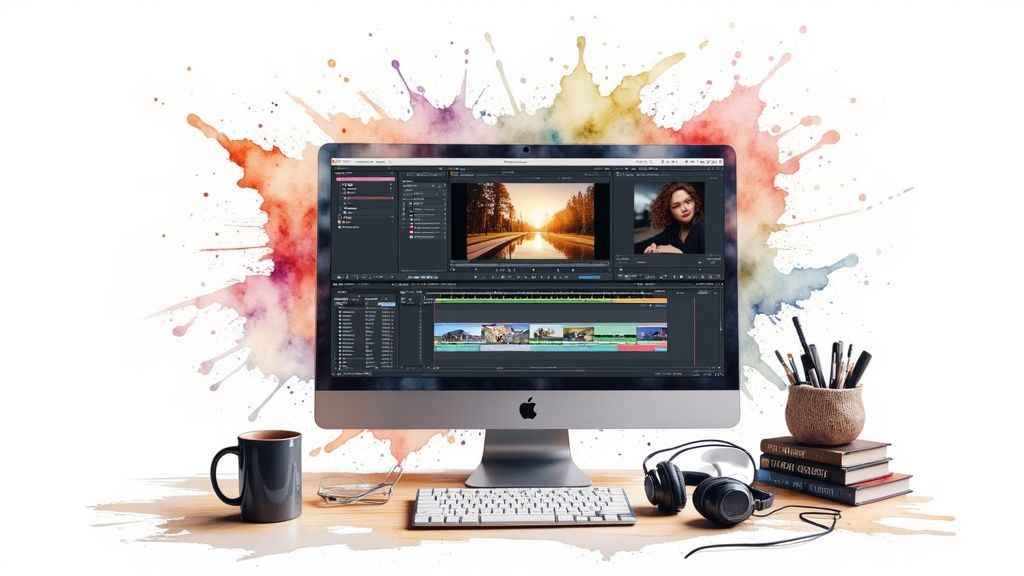Understanding the Psychology of Social Media Video Success

Making videos that truly connect with social media audiences goes beyond technical skills and equipment. Success comes from understanding the core reasons why people engage with video content - what makes them want to watch, share, and take action after viewing.
Emotional Resonance: The Key to Viewer Connection
The most effective videos tap into viewers' emotions. When a video makes people feel something - whether it's joy, amazement, empathy, or even sadness - they're much more likely to engage with it compared to emotionally flat content. Think about viral videos you remember - they probably stirred strong feelings. This emotional pull builds community and motivates sharing, helping expand your reach naturally. For instance, heartwarming videos of kind acts tend to spread much faster than pure information, even with similar production quality.
The Power of Authenticity and Relatability
People can spot fake or forced content immediately. Real, honest videos build trust and make viewers feel personally invested in your message. Show genuine behind-the-scenes moments, share real stories from your experience, or simply talk directly to viewers like you would to a friend. This natural approach helps form real connections with your audience.
Understanding Viewer Behavior and Preferences
The numbers show just how central video has become to online life. Studies from 2023 reveal that 92% of internet users watch online videos regularly. People spend an average of 18 hours weekly watching video content, with 33.33% of all online activity devoted to videos. For more detailed data, check out Sixth City Marketing. These patterns show why understanding viewer habits matters so much for creating effective content.
Utilizing Psychological Triggers for Engagement
Even great content sometimes needs a gentle push to get noticed. This is where specific psychological elements come into play. Using principles like scarcity ("limited time only"), social proof (showing real user experiences), and curiosity (asking compelling questions) can significantly boost how people engage with your videos. These techniques work because they connect with basic human instincts that drive us to respond and take action.
When you understand these psychological principles, you can create videos that truly resonate with viewers, leading to more engagement, wider reach, and better results for your goals. This translates into not just views, but meaningful interaction through shares, comments, and conversions.
Mastering Platform-Specific Video Optimization
Getting your videos seen by the right people requires more than just great content - you need to optimize for each social platform's unique requirements. The key is understanding how technical specs, audience behaviors, and algorithms differ across platforms to make sure your videos perform their best.
Tailoring Content for Different Platforms
Each social platform has specific video format requirements that affect how users experience your content. Vertical videos (9:16) work best on TikTok and Instagram Reels since most people watch on mobile. YouTube viewers expect widescreen (16:9) videos they can watch on larger screens. On LinkedIn, where professionals often browse on desktop, square (1:1) or horizontal videos tend to get better engagement. Adapting your video format to each platform helps you connect with viewers in the way they prefer to watch.
Understanding Audience Expectations and Algorithm Preferences
Different platforms attract distinct audiences with their own content preferences. Young TikTok users gravitate toward quick, entertaining clips, while LinkedIn's professional audience values industry insights and career advice. Success means matching your video's style and message to what each audience wants to see. The platforms' algorithms also favor different things - TikTok promotes videos that keep people watching till the end, so shorter, engaging content often performs better there.
Repurposing Content Efficiently
You can save time by strategically adapting videos for multiple platforms. For example, take clips from a longer YouTube video to create TikToks or Reels that promote the full version. Or combine several Instagram Stories into an extended video for YouTube or Facebook. This approach helps you reach more people while giving each platform the format it prefers. Short-form video has proven especially effective - platforms like TikTok, with its 1.7 billion users and 4.25% engagement rate per post, show how powerful brief videos can be. Learn more about video performance metrics here.
Optimizing Video Length and Formatting
Beyond choosing the right dimensions, video length matters too. TikTok videos work best under 60 seconds, while YouTube rewards longer content that provides real value. Instagram Reels' 90-second limit sits between these extremes. These timing differences reflect how people consume content differently across platforms. Pay attention to video quality specs too - proper resolution and file size prevent playback issues that could frustrate viewers.
By learning the specific requirements and preferences of each social platform, you can adapt your videos to perform better and reach more of your target audience. Focus on giving viewers what they want, where they want it.
Building Your Professional Video Creation Toolkit

Making great social media videos doesn't require expensive Hollywood equipment. With the right combination of basic tools and resources, you can create professional-quality content that engages your audience. Let's explore how to build a video toolkit that grows with your needs and budget.
Essential Equipment for Getting Started
The foundation of any video setup starts with three key pieces. First, you'll need a good camera - even a recent smartphone model can work well for beginners. Second, proper lighting makes an immediate difference in video quality - consider starting with an affordable LED panel or ring light. Third, invest in a basic external microphone, as clear audio is crucial for keeping viewers engaged and makes your content appear more professional.
Leveling Up: Intermediate Tools and Software
As your skills grow, strategic equipment upgrades can improve your content quality. A dedicated video camera with interchangeable lenses gives you more creative options. Adding a gimbal or tripod helps create smooth, stable footage that looks polished. For post-production, start with user-friendly editing software that lets you color correct footage and add professional transitions. For more details, check out How to master video editing software.
Maximizing Efficiency with Templates and Resources
Smart creators know that templates save valuable production time. Using pre-made intros, outros, and graphic overlays helps maintain consistent branding across your videos. Stock footage and music can add professional polish when needed. Research shows that while 35% of marketers create videos from scratch, 48% successfully combine templates with original content - learn more about these trends at G2's Video Marketing Statistics.
Professional-Grade Production for Advanced Creators
When you're ready to take your content to the next level, professional equipment opens new creative doors. High-quality cameras, specialized lenses, and advanced lighting setups can dramatically improve your video quality. Professional editing software adds capabilities like motion graphics and effects. Just remember to choose upgrades that make sense for your specific content needs and budget.
Analyzing Return on Investment (ROI) for Your Toolkit
Smart investment in video equipment requires careful consideration of potential returns. Start with quality basics and upgrade strategically as your skills, audience, and revenue grow. Track which gear improvements lead to better engagement and results. This measured approach helps you build a toolkit that delivers value while avoiding unnecessary expenses. Focus on equipment that directly improves your content quality and helps achieve your video marketing goals.
Crafting Stories That Drive Viewer Action

Making videos that people want to watch and share on social media takes careful planning and storytelling skill. Good videos need a clear structure that pulls viewers in and guides them toward taking action, whether that's liking, commenting, or clicking through to learn more.
The Power of a Strong Hook
Those first 3-5 seconds make or break your video's success. 75% of viewers decide in those moments whether to keep watching or scroll past. Start with something that instantly grabs attention - maybe an eye-opening statistic, an intriguing question, or a stunning visual. For example, opening a cooking video by showing that Americans waste 40% of their food immediately makes viewers stop and take notice.
Maintaining Viewer Retention: Pacing and Engagement
Getting viewers to stick around requires thoughtful pacing. Mix up your shot types, add background music that fits the mood, and include text overlays to highlight key points. Consider adding interactive elements too - pose questions to your audience or use polls to turn passive viewing into active participation. Think of your video as a two-way conversation rather than just talking at viewers.
Crafting Powerful Calls to Action
Every video needs a clear next step for viewers, but it shouldn't feel forced. The best calls to action flow naturally from your story. For instance, if you're showing how to use a product, point out how it solves a common problem, then suggest viewers check out the product page to see more features. You might be interested in: How to master creating YouTube Shorts. This makes your call to action feel helpful rather than pushy.
Developing Your Brand Voice and Storyboarding
A consistent brand voice helps viewers instantly recognize your content. Pick a personality that fits your brand - maybe you're fun and casual, or perhaps more educational and professional. Use storyboarding to map out each video's flow before you start filming. Think of it like drawing a map for your story - you'll know exactly which scenes you need and how they connect to deliver your message clearly.
Script Development: Balancing Entertainment and Strategy
A strong script keeps your message focused while being enjoyable to watch. Each line should serve both entertainment and business goals - whether that's building brand awareness, driving website traffic, or promoting products. Write in a conversational tone that speaks directly to your viewers' interests and needs. The best videos feel authentic while subtly guiding viewers toward taking action.
Maximizing Reach Through Strategic Distribution
Even the best video content needs a smart distribution strategy to find its audience. Simply posting videos and hoping they'll get noticed isn't enough anymore. Let's explore proven ways to get your videos in front of the right viewers and keep them engaged.
Optimizing for Platform Algorithms
Each social platform has its own recipe for showing videos to users. Watch time and engagement are key factors - but how they matter varies by platform. On TikTok, videos that keep viewers watching until the end tend to perform best. YouTube, on the other hand, rewards longer viewing sessions overall. This means you'll want to adapt your content style to match each platform's preferences.
Metadata Mastery: Titles, Descriptions, and Tags
Think of metadata as signposts that help viewers find your content. Your title should grab attention while accurately describing what's in the video. Write descriptions that give context and include relevant search terms naturally. Choose tags that reflect your video's topic and what viewers might search for to find similar content.
Timing is Everything: Strategic Content Scheduling
When your audience is online matters as much as what you post. Study your analytics to spot when your followers are most active. Many creators find success posting during lunch breaks or evenings when people have free time to watch. Test different posting times and track what gets the best response from your specific audience. You might be interested in: How to master content distribution.
Engaging Your Community: Hashtags and Interaction
Building an engaged audience takes more than just posting videos. Pick relevant hashtags to help new viewers discover your content. When people comment, respond thoughtfully to start conversations. This personal touch helps turn casual viewers into loyal followers who'll share your content with others.
Cross-Platform Promotion and Content Repurposing
Make your videos work harder by sharing them across multiple platforms. A long YouTube video can become several short clips for Instagram or TikTok. Each platform has its own style - adjust your content to fit while keeping your core message. This helps you reach different audiences where they prefer to watch.
The Power of Thumbnails: Creating a Visual Hook
Your thumbnail is like a movie poster - it needs to make people want to click. Use clear, eye-catching images that hint at your video's content. Add text that reinforces your title, and make sure it's readable even at small sizes. Try different thumbnail styles to see which ones get more clicks.
Focus on these distribution basics to help your videos find and grow their audience. Remember that great content is just the start - smart distribution helps it reach its full potential. Keep testing new approaches and paying attention to what works best for your specific viewers.
Measuring Impact and Scaling Success

Success with social media video content requires both great creation and smart measurement. Getting real value means looking beyond basic metrics to understand what truly moves the needle for your business goals.
Identifying Key Performance Indicators (KPIs)
Start by getting clear on what you want to achieve. Different goals need different measurements - brand awareness might focus on reach and shares, while lead generation would emphasize conversion rates and click-throughs. Pick the metrics that directly connect to your specific objectives.
Tracking and Analyzing Viewer Behavior
The way people watch and interact with your videos reveals what works and what doesn't. Pay attention to watch time, audience retention, and engagement metrics like comments and shares. For instance, if viewers consistently drop off at the 30-second mark, that section likely needs work.
Utilizing Analytics Tools for Data-Driven Decisions
While social platforms offer basic analytics, specialized tools can dig deeper into the numbers. These tools help spot trends, see how you stack up against competitors, and find new opportunities. The insights guide smarter choices about content creation and distribution.
Scaling Your Video Content Production While Maintaining Quality
After finding what resonates, grow your output thoughtfully. Rather than just making more videos, focus on making better ones. Set up clear processes and templates to keep quality consistent as production increases. A reliable workflow helps maintain standards even as you create more content.
Adapting and Refining Your Strategy Based on Data
Long-term success comes from constant fine-tuning based on real results. Review your numbers regularly and adjust your approach accordingly. Try new formats, topics, and sharing methods based on what the data shows is working. Think of your strategy as always evolving to match what your audience responds to best.
Need help creating impactful social media videos at scale? Aeon offers powerful tools to transform your content into engaging videos efficiently. Our platform helps publishers like you create professional social media videos without the usual hassle.